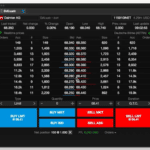Peter Cruddas, the founder of leading spread betting broker CMC Markets was quoted in The Times this morning in an article about the end of churn and burn broking. Cruddas highlighted that the days of high client turnover was gone for CMC and that they were focusing on only the “tastiest fish in the sea” as they go after the most lucrative clients via “project Tuna”.
It’s a pretty decent article by Harry Wilson and well worth a read because it highlights exactly how valuable good clients are. CMC client numbers declined by 2% to 59,165, but revenue per client was up 18% to £2,964 per client. Active clients were up 10% over the past 12 months.
But why no more churn and burn?
I wrote way back in 2014 about why spread betting brokers actually want you to make money and most of that is still the case today.
But specifically for these reasons…
Marketing costs. Anecdotally, the cost for a broker to acquire a new customer has risen from around £300 when I started out as a broker back in the early 00’s to nearly over £1,000 today. So when they get a client they need to look after them. Referrals are always the best type of client and the cheapest to get, plus they tend to be longer term clients and are much more valuable than churn and burn clients.
No more bonus promotions. The FCA quite rightly put the kibosh on brokers offering cash incentives to traders for switching brokers. The derivatives industry has a bad enough reputation as it is as basically being a massive financial based casino. So brokers offering matched deposit bonuses to encourage excessive trading wasn’t doing anyone any favours. It probably attracted the wrong sort of client anyway, who probably would lose money trying to claim the bonus from hedged trading.
ESMA’s cap on margin rates. Cruddas, in his comments highlighted that 80% of the revenue comes from 20% of the clients. This is the case across most brokers. In fact for many it may even be less than that. I would say that in my 20 years as a broker, if I was looking after 100 clients 2-3 would generate the bulk of our revenue, 7 would contribute a significant amount. The other 90 or so would just keep us busy with our eyes on the market and justify all the trading systems until the top 10 came on to trade.
At the end of the day broking is a relationship business, it’s about getting clients on board and looking after them to make sure they have the right access, tools and support to do what they want. It may be a relationship with a specific broker on the desk, a trading platform or even a colour scheme. But looking after you best clients has always been the key driver in successful brokerage.
There is likely to be significant consolidation as the regulators tighten trading criteria and the publishers ban leveraged marketing. Smaller brokers will find it difficult to attract new business and just like when stock market investors flock to bonds, the brokerage industry will also their clients see emigrate on a flight to quality.

Richard is the founder of the Good Money Guide (formerly Good Broker Guide), one of the original investment comparison sites established in 2015. With a career spanning two decades as a broker, he brings extensive expertise and knowledge to the financial landscape.
Having worked as a broker at Investors Intelligence and a multi-asset derivatives broker at MF Global (Man Financial), Richard has acquired substantial experience in the industry. His career began as a private client stockbroker at Walker Crips and Phillip Securities (now King and Shaxson), following internships on the NYMEX oil trading floor in New York and London IPE in 2001 and 2000.
Richard’s contributions and expertise have been recognized by respected publications such as BusinessInsider, Yahoo Finance, BusinessNews.org.uk, Master Investor, Wealth Briefing, iNews, and The FT, among many others.
Under Richard’s leadership, the Good Money Guide has evolved into a valuable destination for comprehensive information and expert guidance, specialising in trading, investment, and currency exchange. His commitment to delivering high-quality insights has solidified the Good Money Guide’s standing as a well-respected resource for both customers and industry colleagues.


